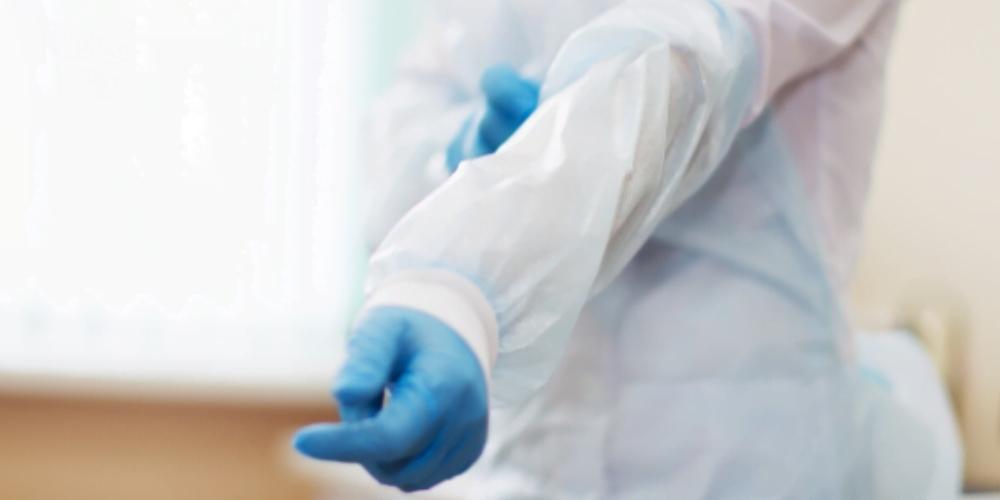Due to the nature of the COVID-19 pandemic, physicians have been ordering imaging scans to examine and diagnose patients with symptoms of the respiratory virus. As diagnostic imaging professionals are called upon to perform scanning, infection control and ultrasound disinfection practices have become an urgent concern for both the safety of the clinician and the patient.
The highly contagious COVID-19 virus can be transmitted through the air and surfaces. Many physicians have turned to ultrasound as a method of diagnosing patients and monitoring confirmed cases. Ultrasound scans such as these require the clinician to be near the patient, and as a result of the proximity, the risk of COVID-19 transmission is increased.
In addition to the proximity between patient and clinician, ultrasound disinfection must also be taken into consideration when establishing an infection control protocol for diagnostic imaging. The CDC has confirmed that human coronaviruses, such as COVID-19, are able to live on surfaces for up to days at a time. Therefore, proper ultrasound disinfection with medical-grade sprays and wipes coupled with high-level disinfection can reduce the risk of contaminants. Moreover, if possible, facilities can set aside an ultrasound transducer for suspected and confirmed COVID-19 patients as part of the infection control plan to isolate the equipment from non-essential staff and other patients.
To assist ultrasound technicians in protecting themselves and their patients, the American Institute of Ultrasound in Medicine (AIUM) recently released a series of guidelines to improve ultrasound infection control efforts and reduce the risk of transmission.
“The AIUM strongly encourages cooperation among employers, sonographers, and manufacturers to promote a safe work environment,” the group said in a statement.
While these recommendations can be used as general guidelines, the organization reiterated that ultrasound technicians should be sure to comply with all regulations and infection control protocols implemented by their medical practice. Furthermore, they should be sure to follow all local government and Centers for Disease Control & Prevention (CDC) recommendations for infection prevention and ultrasound disinfection.
The AIUM published the following nine recommendations for ultrasound infection control:
- Clinicians with pre-existing conditions that make them vulnerable to COVID-19 should have limited contact with confirmed or suspected patients.
- Those performing scans should complete infection control training and have respirators on hand, such as N95 and FFP3, if required.
- Appointment times should be strictly followed and spread out to avoid crowding in the waiting area. The number of patients being examined should be minimized as much as possible. Furthermore, the seats in the waiting area should be spaced at 6 feet apart. If possible, patients and caregivers should be supplied with masks upon arrival.
- Do not permit visitors to enter the exam room with the patient, including medical trainees and students.
- It is better to assume that every patient has COVID-19 and to clean and disinfect both the ultrasound equipment and the room at the end of each clinic.
- Hand hygiene protocols should be strictly followed. Perform hand washing after every patient encounter, any contact with potentially infectious material, and before and after removing personal protective equipment (PPE). Clinicians should use latex-free disposable gloves during the ultrasound exam and change them after each patient encounter.
- To prevent cross-contamination due to aerosols and particulate matter, perform the ultrasound scan with one hand on the transducer and one on the keyboard and machine controls. Contaminants can accumulate to the crevices of the keyboard.
- If the patient is being scanned in isolation, put on PPE before entering the area.
- Any reusable PPE should be properly clean and decontaminated. When in close contact with patients, wear surgical facemasks and put them on prior to entering the room. If N95 respirators or higher are at your disposal, use them instead of a facemask. In addition, ultrasound technicians should wear reusable or disposable eye protection. Put on clean, non-sterile gloves before entering the room and then dispose of them when leaving the room and perform hand hygiene immediately. When scanning the patient, a clean isolation gown should be worn and reusable gowns should be kept in a dedicated container. If there are insufficient number of gowns, then prioritize them for aerosol-generating procedures and high-contact patient care encounters.
In addition to these recommendations, technicians can play an important role in infection control by taking proper disinfection measures, such as those for medical imaging equipment. Using ultrasound probe covers as well as storage covers can help reduce the risk of contaminants getting on the probe. In addition, staff can practice ultrasound disinfection with hospital-grade disinfectant sprays and wipes to kill surface bacteria. Moreover, the probe can undergo high level disinfection depending on the procedure. Taking steps such as these reduces the risk of transmission during an ultrasound exam, and can improve the safety of both patients and clinicians.







